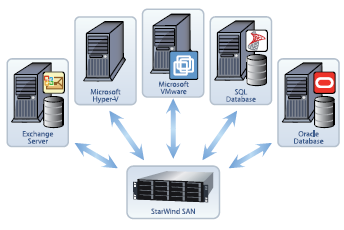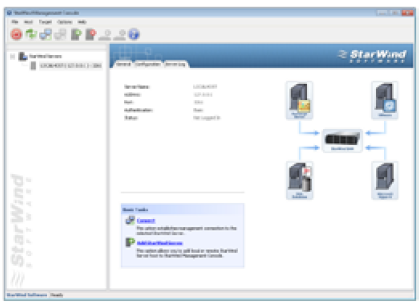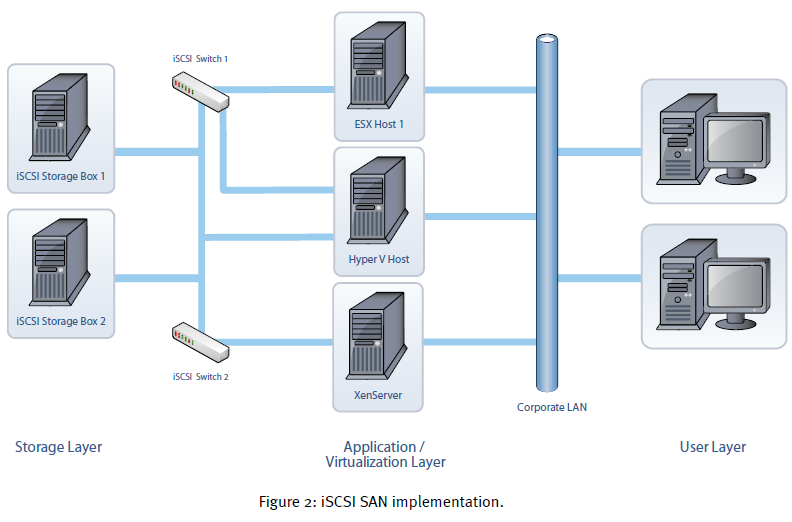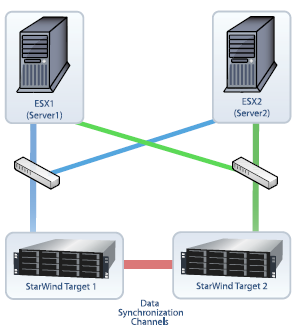The IT Challenge for Educational Institutions
First, we will define several tasks that inevitably present themselves to IT System Administrators and technical advisers. Networks must provide connectivity across campuses with high quality of service levels, data security must be guaranteed to protect the privacy of students and both applications and data must be accessible and available when needed. When these elements are in place, many new possibilities present themselves to IT Departments to serve students, teachers and staff.
When desktops and servers are connected to a network, students and teachers have access to various resources such as online lectures, student assignments, projects, tests, online libraries and much more. Professors can give online video tutoring & lectures, webinars, mark assignments and tests online. This is a pleasant bonus to the core educational process, although providing the backend infrastructure to make this happen is critical to developing a technology proficient graduate ready for today’s work world, while improving the entire learning process and enhancing the prestige of your educational institution.
One of the key corner stones that makes IT easier to use and manage, allowing the full range of benefits from server & desktop virtualization and extending your network into a disaster recovery resource is a SAN (Storage Area Network). The goal is to manage all your data storage as a single pool, one resource that can be divided up as needed and allocated to individual applications and users while being managed and backed up as a single device.
Implementing a SAN requires some upfront planning to avoid issues with performance and scalability as the IT infrastructure and/or storage performance demand increases. You need fast (1 GigE) and redundant Ethernet connections from servers to the SAN along with a backup system that can keep up with the higher speeds available when backing up from a SAN. Any single point of failure with the SAN, switches or server NICs can cause downtime and even data loss, so redundancy is a key element to implementing a SAN.
High Availability, reliable backups and no downtime – all these items can be guaranteed by StarWind iSCSI SAN software. Many StarWind customers in the educational sector use StarWind Software solutions not only to provide availability of existing IT storage resources within the organization, but also to teach and train students enrolled in technical courses to deploy storage area networks, virtualization and disk backup solutions based on the iSCSI protocol. Using StarWind enables best practices for effective storage, backups, replication and server virtualization without incurring high costs.
A SAN is centralized and manageable network storage, SAN architecture provides ways to perform storage tasks easier and with more reliability. You can create shared storage for servers and manage the SAN remotely. Using the iSCSI protocol a SAN is the most economical and practical solution for schools and colleges with limited IT budgets that want to take control of the growing costs and complexities associated with managing storage, backups and virtual server & desktops. Our customers experience shows it clearly: Poquoson City Public Schools in Virginia and Oklahoma State University both use StarWind iSCSI SAN software for shared storage in their school networks reducing administration overhead and increasing storage and application uptime.
A major benefit of StarWind iSCSI SAN software is compatibility with any type of hypervisor. This is a significant point since many educational institutions receive significant discounts from Microsoft allowing Hyper-V to be implemented at an extremely low acquisition cost. StarWind iSCSI SAN solutions are qualified for use with Microsoft Hyper-V, VMware and XenServer.

The technical details on what a SAN is composed of and how to plan and size a SAN are outlined in the rest of this paper.
What is a SAN?
SAN is an acronym for storage area network – it is a shared storage box that can be provisioned to servers over a dedicated network. The term SAN is commonly used to refer to dedicated storage servers that use either the Fibre Channel (FC) or the iSCSI protocol. By carrying SCSI commands over IP networks, iSCSI is used to facilitate data transfers over intranets and to manage storage over long distances. iSCSI simplifies the implementation and management of the SAN. Conversely, FC storage requires expensive switches and host cards (HBAs), and by design forces you to put your SAN on a completely separate Fibre Channel network.
Enterprise SANs typically come with options for single or dual controllers for redundancy, and can allocate disks based on various RAID levels as required by your application servers. In essence, application servers don’t behave any differently when connected to a SAN, other than you may actually see an increase in storage performance, and with the right SAN selected overall server management will take less time.
With the iSCSI protocol, it is entirely possible to connect iSCSI storage directly into your existing corporate IP network, also known as your LAN. However, your LAN should not be designated for your SAN even though it is possible to use it for that purpose. This design could flood the corporate LAN with storage traffic which may slow everything down. So even with iSCSI storage, you should use separate network interface card (NIC) ports on application servers and separate (and redundant) IP switches to connect to the storage device using multipathing to eliminate a single point of failure on the SAN fabric. This will ensure you use a secure, segmented network for storage traffic that will not adversely affect your LAN and existing network traffic.
What do SANs provide that you can’t get from Direct Attached Storage (DAS)?
Why use a SAN in the first place? You may think direct attached disks are working just fine, but consider that a SAN provides following benefits not just for primary storage, but also for backups, recovery, off-site replication and allowing advanced functionality in virtual server & desktop environments.
A SAN allows you to use advanced features of virtual machines, migrate VMs between physical host servers without any downtime, and easily manage hardware resources and power down a physical server for repair or maintenance, all without impacting applications. Using features such as Vmotion, Live Migrate or XenMotion (depending on your vendor of choice) provides VMs with a fail-safe shared storage environment without purchasing additional specialized SAN hardware. Moreover, you can implement high-availability clustering at the OS level and use features such as DRS to enable auto load balancing between physical servers.
Advanced Data Protection – Replication, Snapshots, Thin Provisioning
Replicating data off-site over Ethernet using an iSCSI SAN provides a cost effective solution for Disaster Recovery, eliminating the need to purchase higher cost SAN hardware and reducing the overhead of host based replication. StarWind iSCSI SAN includes synchronous and asynchronous mirroring, and synchronous mirroring used in HA mode for a fully redundant SAN architecture.
Thin Provisioning is a SAN feature that essentially deceives the operating system into thinking it has a larger disk partition that the actual physical disk available. This allows you to purchase as much physical disk as is required in the near term, while eliminating the need to make any changes to application servers when adding more disks to the SAN.
Snapshots provide means for fast backups and restores on the SAN. Snapshots take up only enough space to hold block level changes, hence the amount of disk space snapshots take is minimal compared to differential backups. In addition, replicating data offsite from a snapshot reduces the impact on primary data so that applications don’t suffer I/O lags during replication, allowing data to be more easily replicated during production hours. Cloning full volumes can be used to create a full backup on disk, or to copy an entire volume for testing or development without affecting primary data.
Why iSCSI Storage?
The section above hints at why iSCSI storage is advantageous, however, prior to getting into additional details, it is important to mention that iSCSI storage can work in a mixed protocol environment. For example, if you already own a FC SAN and don’t plan to replace it, then iSCSI may be the most rational decision for a) new virtual machine deployments b) application servers that are not SAN attached but have outgrown their direct attached disks c) as an iSCSI disk-to-disk backup appliance or d) a pure VTL (virtual tape library).
Now consider why you should implement iSCSI storage when you can also select from NAS (Network Attached Storage), DAS (Direct Attached Storage also known as local hard disks), or a FC SAN (Fibre Channel).
iSCSI storage is based on the iSCSI protocol, which means the disk drives in your storage appliance are presented over an IP network using the SCSI command set. Don’t confuse this with traditional SCSI disks; in fact, iSCSI storage is typically implemented with affordable Serial Advanced Technology Attachment (SATA) or Serial Attached SCSI (SAS) disks. iSCSI presents block based storage just as you get with your internal disk drives, whereas a NAS is a just a plain file server, which presents storage as file shares. A common scenario is to use a portion of your iSCSI SAN storage as back-end disks for file servers (NAS), consolidating both application data and file shares into one appliance.
Now a little about iSCSI security, which allows IT administrators to specify which client machines (initiators) are able to connect to the iSCSI storage servers (the iSCSI target). Challenge Handshake Authentication Protocol (CHAP) is used to provide authentication between application servers and the iSCSI storage. Because CHAP identifiers are changed frequently and because authentication can be requested by the SAN at any time, CHAP provides a high level of security, even more so than Password Authentication Procedures (PAP).
iSCSI storage is Ethernet-based, so IT Administrators only need basic IP networking knowledge, as opposed to more specialized FC networking skills. There is a common misconception that FC offers better performance than iSCSI, but with correct sizing to determine the speed and number of disks required to achieve the necessary IOPs (i/o’s per second) for optimal application performance, iSCSI has proven to be more than up to the job of even the most demanding applications. FC storage is significantly more expensive than iSCSI, requiring proprietary FC HBAs (Host Bus Adapters) on client machines as well as more expensive FC network switches. Also, managing and maintaining a FC SAN requires administrators to learn new skills in FC networking. While the price is significantly higher for FC, the performance does not justify the increased cost. Ultimately, while Fibre Channel bandwidth is indeed higher (that is, until everyone has 10GigE implemented), the most common bottleneck is actually the speed of the hard disks and not the network connection.
Therefore, iSCSI storage allows you to use standard IP switches and application servers can use a simple software called an “Initiator” instead of an expensive FC HBA card. For older application servers with lower powered CPU’s, you can use an iSCSI TOE NIC that offloads storage processing onto the NIC, which is still affordable, unlike the FC HBA counterpart. For instance, Microsoft offers a freely downloadable software iSCSI Initiator and all new versions of Microsoft Windows already include the Microsoft iSCSI initiator. Microsoft has eagerly endorsed iSCSI technology for Windows, helping to promote iSCSI awareness. Linux based iSCSI initiators are also freely available.
For organizations that have already invested in FC as their primary storage and require lower cost Tier 2 storage, using iSCSI for the lower cost tiers will provide significant cost savings over FC. It is also a growing trend within the industry to implement iSCSI storage in a mixed environment, where existing FC storage may be legacy but still under warranty or the performance of FC is required for extremely I/O intensive applications, such as high transactional databases with many hits per second. In any mixed storage environment, iSCSI can be an ideal choice for many applications from Exchange, SQL Server to VMware or Hyper-V.
In fact, iSCSI storage is already in use by many companies from SMBs to the Fortune 500 companies. The simplicity of using a Windows application, referred to as a “Target”, to provide iSCSI storage allows you to use the Microsoft Windows operating system as the SAN controller and have a fully functional iSCSI SAN with an easy to use and familiar user interface. Any IT administrator familiar with Windows should be able to install and configure a Windows SAN in less than 30 minutes. Microsoft is one of several companies that provide iSCSI storage software for Windows; another is our featured product the StarWind iSCSI SAN.
What can you do with a StarWind iSCSI SAN?
• Use all the features of server & desktop virtualization such as Vmoton & HA (VMware) or LiveMigrate (Hyper-V).
• Manage unlimited Terabytes of disk space.
• Use Thin Provisioning to save disk space & reduce storage providing times.
• Replicate data off-site or to a local backup server.
• Perform point in time snapshots for fast disk-to-disk backups and restores.
• Clone entire volumes for testing or backup.
• Turn direct attached storage into a SAN.
• Increase storage security with the iSCSI standard.
Building Your Own SAN
Once you download and install the StarWind iSCSI SAN software, it should take you no more than 15 to 20 minutes to be up and running. StarWind can be installed on any x86 server running 64-bit or 32-bit Microsoft Windows, which allows you to select your preferred hardware vendor (i.e. Dell, HP, IBM, or any whitebox server) or to repurpose any existing server that may have become available after consolidation or implementation of VMware or Hyper-V virtualization environments.
Before installing StarWind, note that you will get the best performance and experience with your iSCSI SAN by selecting your hardware according to the following simple guidelines. In general, the performance required from the physical server where StarWind is installed isn’t as critical as sizing the disks correctly, although it is still important to note that the CPU speed and amount of RAM will affect the system’s performance.
A few key points are outlined below to make your experience of building your own SAN run smoothly. First, here’s a list of basic ingredients you can adjust to suit your taste:
•Software: StarWind iSCSI SAN software.
•x86 or x64 Server: Any Intel-based or AMD-based server will do that is capable of running any of the Microsoft Windows Server editions. For most storage applications, 2-4GB RAM and a 2GHz CPU (single core) will be good enough. Dual power supplies are recommended for critical applications.
• Windows Operating System: A server class Windows OS is recommended. Both 64-bit and 32-bit OS’s are supported.
• Disks: SAS or SATA disks (as long as the Windows OS can see them you are fine). A minimum of 2 disks will provide basic RAID protection.
• IP Switches: A dedicated 1GigE switch for the SAN fabric. Budget IP switches are not recommended for performance reasons. A second switch is optional, although highly recommended if connecting mission critical applications to the SAN.
Jumbo frame support is recommended for optimal throughput.
• NICs: 2 X 1GigE NIC ports – a single NIC port will also work for applications with low I/O requirements. Two NIC ports dedicated for storage traffic eliminate a single point of failure at the NIC level.
• Client Connections: : Free Microsoft iSCSI initiator can be used, as well as various Linux, Unix initiators, iSCSI HBAs and iSCSI TOE NICs.
Here is a sample server configuration for your custom-built SAN that will offer excellent performance:
Windows Server 2008 R2 x64
2 x Dual Core CPU (Intel)
8GB of Memory
1 x RAID Controller (SATA and SAS Backplane support)
2 x 1GigE NICs (Jumbo Frame support) or 10GigE NIC
Sizing disks involves selecting the correct speed drives and the right number of drives to achieve the required IOPs (i/o operations per second) for your application. In most cases you can use the same (or faster) drives as in your existing servers as a good starting point.
StarWind will work with any disk that Windows can see (SAS, SATA), and storage can be expanded by using an expansion bay such as external bay of SAS drives. Using a server with hot swappable drives provides extra resiliency in the event of a drive failure. How you decide to carve up a RAID group (many LUNs spread across a single RAID group vs. each LUN on a separate RAID group) is a function of the performance your applications require.
To make sure that your IP network is utilized correctly, you should use a dedicated NIC port on your application servers to connect to dedicated IP switches, which are only used for iSCSI traffic. This will ensure that you don’t overwhelm your LAN. This is the cornerstone of a SAN, which is by definition a separate network for storage. For further redundancy on your SAN network, you can use two separate switches in a crisscross fashion. This requires either dual NICs or two available Ethernet ports on each application server and again on the server running StarWind iSCSI SAN software.
If you are using StarWind as a backup to disk appliance and you only have a single backup server, you can get away with a simpler direct connection and eliminate a switch altogether. Multipathing will provide redundancy or NIC teaming to improve data flow. Multipathing with StarWind is achieved using industry standard MPIO capabilities, and is simple to configure via the Microsoft iSCSI initiator (fully supported with StarWind Software).
In large I/O environments, adding more NIC ports to the StarWind server will allow even more data throughput. Unlike many dedicated SAN vendors, a StarWind SAN allows you to grow NIC ports without purchasing a new SAN.
Also, ensure you are using a 1GigE network for all SAN traffic.
Anything slower will likely not provide enough storage performance. If you need additional performance, using a 10GigE dedicated IP network for SAN traffic will assure you achieve higher performance at a fraction of the total cost of FC storage and FC switches.
On Windows clients (your application servers), the free Microsoft iSCSI initiator is used to enable the client machine to connect to your new SAN. StarWind has also been validated with Linux and UNIX iSCSI initiators, iSCSI HBAs from Adaptec and QLogic, and hardware iSCSI accelerators from Alacritech.

Figure 1: StarWind central management console interface.

Protecting Data with a SAN
Once you have centralized/shared storage in place, one of the first questions you should ask yourself is how will you back up the data that resides on the storage server? With data on a StarWind SAN, you can still use your existing backup application to backup your data, and for VMware users you can also use VCB (Virtual Consolidated Backup). StarWind SAN also allows you to perform live, point-in-time snapshots with the CDP and volume full copies. For a robust disaster recovery strategy StarWind can also replicate data offsite.
StarWind’s Enterprise Class SAN Features
StarWind turns any industry-standard x86 or x64 Windows server into fail-safe, fault-tolerant storage that will be continuously available even in the event of failure. StarWind redefines high availability storage by offering this enterpriseclass technology, which was previously only available in high-end storage products, to small and midsize companies at an affordable price. This combination of true active-active high availability and affordable price is unprecedented.
The following is an example of setting up a High Availability configuration with a server cluster and 2 active-active storage nodes that have automatic failover and failback using VMware as an example:

StarWind’s iSCSI SAN software is available as an activeactive high availability (HA) configuration, or in single node configurations. The active-active HA architecture provides continuous and non-disruptive access to storage in the event of failure by synchronously replicating (mirroring) data between two active storage nodes, all in real time. HA is important to IT professionals as it eliminates a single point of failure at the storage node level, providing for zero data loss in the event of a failed storage node. If a disk, power supply or even an entire storage node fails, the remaining iSCSI storage node will take over and continue to operate without any disruption, ensuring the SAN is still available and accessible on the network.
StarWind turns any industry-standard Windows Server into a fault-tolerant, fail-safe Windows iSCSI SAN and is qualified for use with VMware, Hyper-V, XenServer and Linux and Unix environments. A StarWind iSCSI SAN is ideal for use anywhere shared storage is required such as for virtual machines, Windows server clusters or back up to disk.
Following is a summary of the key enterprise class features available with a StarWind SAN:
•High Availability / Automatic Failover: Fault tolerant activeactive technology eliminates a single point of failure.
•Failback with Fast Synchronization: Automatic failback to a working storage node.
•Mirroring / Synchronous Data Replication: Real-time data replication between a multi-node storage clusters for a highly available SAN.
•CDP & Snapshots: Capture point-in-time snapshots with unlimited rollback points or make full volume copies.
•Thin Provisioning: Allocate space dynamically for highly efficient disk utilization and simplified storage provisioning.
•High-Speed Cache: Adjust the cache of each SAN controller to maximize performance. Since StarWind runs on standard x86 servers you can use as much system RAM as you have installed.
SUMMARY
As you can see, the process of creating a SAN in your educational institution is as simple as provisioning a new server and Ethernet switch once you have done some basic network planning and defined your goals. With StarWind you have the ability to implement a fully functional, highavailability iSCSI storage area network that can be managed using a simple Windows user interface. IT administrators gain obvious advantages when using an iSCSI SAN and, at the same time, keep within the limits of limited budgets.
This guide is meant to be a brief introduction to building your own SAN. Please refer to the more in depth “Best Practices Guide”. To obtain discounts or for any help choosing the right SAN configuration contact StarWind sales (sales@starwindsoftware.com).
Also be sure to read our customer case stories to help with your decision criteria when learning how an iSCSI SAN can help your educational institution www.starwindsoftware.com/customer-cases

